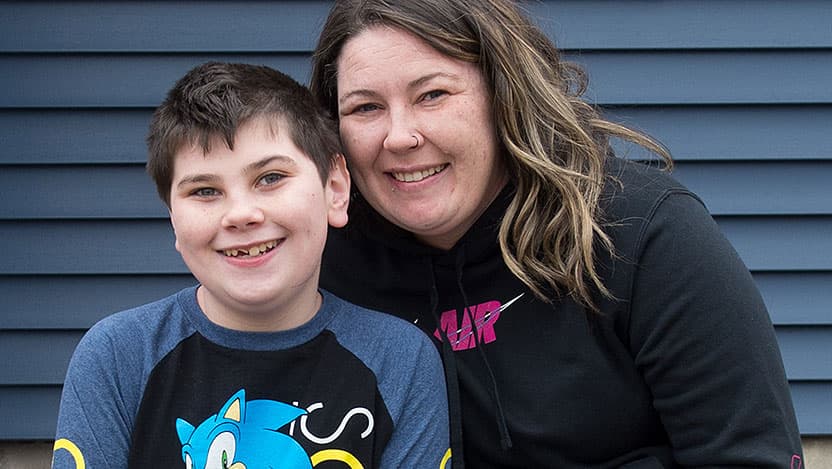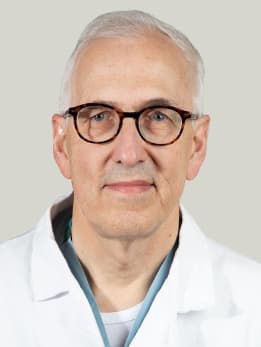Neurosurgery team performs laser hemispherectomy on child with epilepsy

For only the second time in the world, doctors at the University of Chicago Medicine Comer Children’s Hospital and the Department of Neurosurgery used a minimally invasive surgery to disconnect the right and left sides of the brain and the left epilepsy-generating zones in a boy with epilepsy, stopping his seizures.
Neurosurgeon Peter Warnke, MD, performed the 8-hour laser functional hemispherectomy surgery in February 2021. The patient, Zachary Kurek from northwest Indiana, who was 11 at the time, suffered a stroke at birth, causing him to lose most of the function of the left side of his brain.
His epilepsy was getting worse as he got older, causing dozens of seizures a day that medication couldn’t control. Anything startling, such as a loud noise or a barking dog, could trigger a seizure, causing his body to lock up and fall. Zachary suffered countless bad bruises, a few broken bones and teeth, embarrassment, stress and the inability to do many normal activities. His mother said he was becoming depressed, angry and unable to sleep.
With Zachary facing a lifetime of these seizures and with very limited function in his left cerebral hemisphere as a result of the stroke, Warnke and his team studied the boy’s case. They determined that they could completely disconnect the right and left sides of his brain, and separate any epileptogenic tissue in the left hemisphere, without worsening his verbal or physical functioning.
That way, if seizure activity occurred in the left side of his brain, it would be unable to send signals to the right side of the brain or to the fibers that transmit seizure activity, so Zachary’s body wouldn’t react. The neurosurgery team used sophisticated imaging of his brain’s fiber connections that would need to be disconnected by lasers.
A laser hemispherectomy is a highly complex, risky and challenging operation to help people with epilepsy. UChicago Medicine, which is a Level IV Pediatric Epilepsy Center, has performed more than 250 laser surgeries, Warnke estimated.

But to completely disconnect a whole hemisphere with implanted laser fibers was a new challenge. Rather than remove a portion of the skull to access the brain, as traditionally done in a procedure called a callosotomy, Warnke and his team drew on their previous research, which they were first to publish, suggesting that interstitial lasers could be used to disconnect the two hemispheres of the brain.
“If we could replace open surgery with this, that would be a major breakthrough,” said Warnke, UChicago Medicine’s Director of Stereotactic and Functional Neurosurgery. “We’ve entered uncharted territory, but added a new level of safety as the surgery is carried out in the MRI scanner. It provides continuous vision and real-time monitoring of the brain temperature and imaging of the cell damage produced.”
Not only have the seizures stopped, but his whole attitude has changed. He’s optimistic and happy now.
Warnke and his team have since done two more successful laser surgeries like this on other patients, he said.
It's been almost three years since Zachary's surgery and he hasn’t had a single seizure, his parents said. Warnke described his progress as “remarkable.”
“Where we’re at now is amazing,” said his mother Amanda Morey. “Not only have the seizures stopped, but his whole attitude has changed. He’s optimistic and happy now.”
Warnke performed the surgery using an MRI-guided Visualase laser ablation system. Five small holes about the size of coffee stirrers were drilled into Zachary’s head and catheters were inserted. Five laser fibers were inserted into those catheters and moved deep into Zachary’s brain. Constant guidance from an MRI, providing the exact location and temperature of the laser fibers every seven seconds, allowed Warnke to use the laser’s heated tip to ablate and seal off the connections between the two brain hemispheres.
In the future, laser epilepsy surgery at Comer Children’s will be done using a new state-of-the-art robot. The robot will be able to insert the laser fibers in the brain with greater speed and precision, shortening the surgery time.
Julia Henry, MD, Zachary’s neurologist and epileptologist, said UChicago Medicine treats more children for seizures than any other hospital in the Chicago area and has a team of epilepsy experts.
Zachary’s case was discussed by a team of doctors with a wealth of experience and knowledge. When medications weren’t working, Henry told Zachary’s mother about different surgical treatment options available to him. He then underwent additional EEG evaluation and specialized imaging, which concluded that he’d be a good candidate for a hemispherectomy. With the family’s consent, Henry brought Zachary’s case to the Epilepsy Surgery Conference for review. That’s where Warnke proposed doing the surgery with a new laser technique.
Henry encourages parents whose children are not having success with seizure medications to talk to their doctors about surgical options. While a laser hemispherectomy might not be appropriate for every patient with epilepsy, Henry said the risk of death is less than 1%, and between 73% and 83% of children have their seizures cured by surgery.
Knowing what I know now, I wouldn’t have hesitated, and I wouldn’t have waited this long. It worked out perfectly for him.
“This surgery is a big and scary procedure. Disconnecting half my child’s brain? That’s a lot for any parent to process. But the results can be so dramatic,” Henry said. “The kids come to us so impaired. They have bad, frequent seizures. Life is really a struggle. There are a lot of patients who might be good candidates for this, and this minimally invasive approach might open up the option for them.”
Zachary remains on anti-seizure medication because it’s still possible he could have a seizure. But his quality of life has improved dramatically. As of October 2023, Zachary was getting all As and Bs in school and playing basketball – things that wouldn't have been possible if he was still having seizures.
After his surgery in 2021, mother and son were getting out of the car when a wind gust suddenly slammed the car door shut. Instinctively, Zachary braced himself for a seizure but then realized nothing was happening. He looked at his mom and smiled, and said, “Oh yeah! I don’t have seizures anymore!”
“There was so much that he went through, and I was very hesitant to do this surgery at first. I kept thinking about all the ‘what ifs’,” Amanda said. “Knowing what I know now, I wouldn’t have hesitated, and I wouldn’t have waited this long. It worked out perfectly for him.”

Peter Warnke, MD
Internationally renowned neurosurgeon Peter Warnke, MD, has performed more than 5,000 stereotactic surgeries and more than 2,000 brain tumor surgeries. Dr. Warnke provides neurosurgical care for the treatment of adults and children with movement disorders, epilepsy and brain tumors.
Learn more about Dr. Warnke